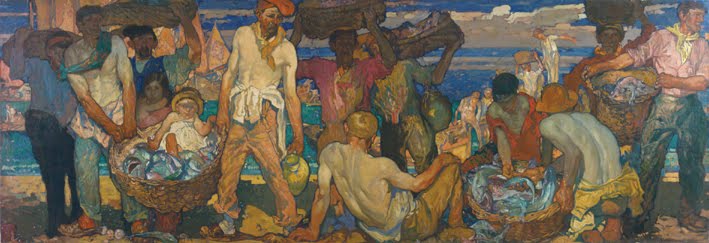 |
| Don Driver's Yellow Tentacle Pram |
To commemorate its 125th year, the Dunedin Public Art Gallery features an installation called Beloved. Comprised of some of the gallery’s finest works from the collection, it spans a timeframe of 600 years and is contemporary in its presentation. The artworks are grouped according to theme rather than chronology and are displayed against a vibrant set of colours.
First to grab attention is a room called New Sensations against sky-blue walls. First I take notice of Ani O’Neill’s Kua Marino te tai (The Sea is Calm) which unspools from the wall – a sheet of woven white florist ribbon. She combines the horizontal and vertical movements of weaving to suggest a confluence of traditional and fine art forms from her dual backgrounds of Auckland and Cook Islands. The star-shapes intimate the navigational arts that guided her forebears here, while the white fabric with patterned spaces is the negative image of the night sky. Almost quilt-like, this art-work is both comforting and confronting.
 |
| Spes, or Hope |
The room is dominated by When the Sun Rises and the Shadows Flee by Reuben Paterson. An industrial fan blasts the acrylic shimmer discs on board, which depict palm trees and beaches in garish hues. Metallic shoes are abandoned on the floor in a heap of tangled blue streamers, presumably meant to represent seaweed, and the hedonistic escapism of a summer holiday. Apparently he has taken his trademark glitter to a size he calls 'god-sized' to embody other people's dream-like imaginings. It proves that bigger is not necessarily better as subtlety is sacrificed to size.
 |
| When the Sun Rises and the Shadows Flee |
I prefer Don Driver’s Yellow Tentacle Pram (1980) which allows for more interpretation by the viewer. The pram full of bright yellow ribbed piping suggests a myriad of possibilities: a domesticated octopus; a mobile drainage unit; a 3D tantrum; a giant fancy-dress clown wig; Brobdingnagian spaghetti; transportation of slapstick prosthetic limbs... A black comedy of cast-off objects, it also alludes to the devoted parent, trundling his artworks from place to place.
The next room features works assembled under the title of Proud Flesh. Bursting forth from the black walls they explore the thin line between one person’s rapture with and another person’s repulsion to the physical form. Tony Fomison’s Mugshot was the highlight for me – I have admired his work before. The oil soaks into the hessian backing and makes the painting look rough and rural, as though the artist was moved to create with whatever material came to hand in desperation to express himself, just as the subject of the portrait gurns with ecstasy or grimaces with anguish, depending on the viewer’s mood.
 |
| Unloading the Catch |
Unloading the Catch by Frank Brangwyn is a mêlée of writhing flesh, both masculine and piscine, with lurid colours and overtones of Gauguin. The large canvas dominates the room, but I am also intrigued by Maybe Tomorrow by Alvin Pankhurst. In a highly stylised version of a typically Victorian house we see a face of a man in a mantelpiece, and his back in shadow. The ornate wallpaper and the designer crockery are partially obscured by creeping tree-roots, waving tendrils of memory and indicating the passage of time.
 |
| Waiting for the Train |
Bright red is the background for Sense and Sensibility, a compilation of male and female portraits and dainty pieces of furniture. Not being a huge portrait fan, this is my least favourite room, although the placement of Jacques-Joseph Tissot’s Waiting for the Train (Willesden Junction) here makes the work shine all the more among its counterparts. Also worth admiring, as always, is Frances Hogkins, represented by Still Life with Fruit Dishes. Robin White’s Sam Hunt at the Portobello Pub (1978) makes much of the contrast between the stern lines of the building and the gangly elegance of the poet, reflecting the curve of the bar’s doorhandles in the insouciance of his bent arms.
The splendour of nature in all its guises (from formidable foe to gentle ally) is represented in So Far Away, So Close, which is suitably in the sage green room. The variety is most pronounced here from Joseph Mallord William Turner’s wide, sweeping, atmospheric Dunstanborough Castle, Northumberland, to Laurence Lowry’s tight, pinched, political Lancashire Industrial Scene. I don’t quite see the rationale for grouping André Derain’s Un Paysage with Walter Sickert’s Old Heffel, the Fiddler, but I’m sure the curators had their reasons.
 |
| Preparation for the Market |
 |
| The Bosom of Abraham |
2 comments:
Great blog. I love Gretchen Albrecht's work. http://caroleschatter.blogspot.co.nz/2011/12/gretchen-albrecht-abstract-artist.html
Thanks Carole,
I popped over to visit your blog and love your work! I shall follow with interest.
Cheers
Kate
Post a Comment